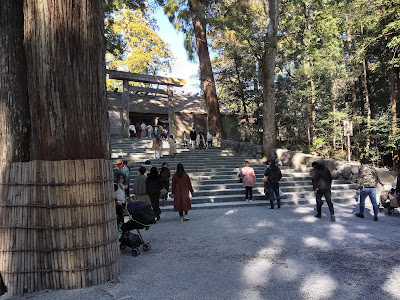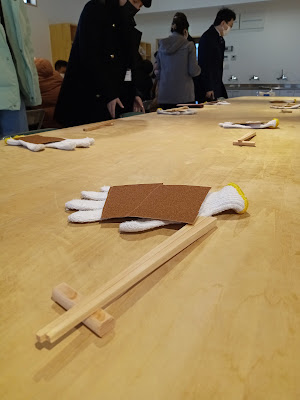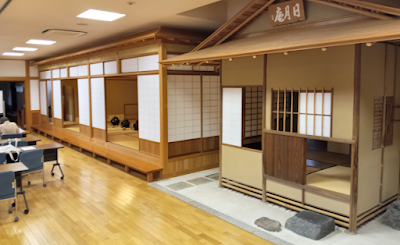Day-2 topics and field trip to the Inner Shrine (内宮), Naiku
Today was the first chance to test the commuter bus IC cards to ride to the campus and walk up the hill to the library, where sessions are being held during the university's spring break. We learned about the history of the Ise Jingu (collective group of lands, shrines, kami, religious specialists and traditions, as well as all those coming to pay their respects) from Pr. I and after a short break we continued in lecture and question-answer with Pr. S, who features most prominently in the 2023 cycle of the Ise and Japan Study Program as field trip guide, lecturer, and source of encouragement to the seminarians. For the Wednesday morning session, we learned about the afternoon's subject to visit, the Inner Shrine of the Jingu, known as the Naiku or Kotai Jingu, (map) where one of the earliest and most prominent kami is celebrated, Amaterasu-no-Omikami (天照大御神).
 |
| No cameras or recording beyond the bottom step to the Kotai Jingu. |
Visitors to the Naiku are faced with an ocean of shrines, kami, woodland, rivers, mountains. So it is easy to be distracted and forget what the main idea of Shinto is. In the eyes of a newcomer to this bundle of traditions and practices, the main idea seems to be to develop a posture or attitude that connects self to the surroundings, including social landscape, which is righteous (or upright, proper, appropriate) and sincere (guileless, well-meaning) and pure (alert to things detracting to being sincerely right-living. There is a faint echo here of the tension within the Bible of the Pharisees: being fastidious about the Law, but at risk of worshiping the Law instead of using it as a support or frame that guides one's interaction and relationship to God, the people, the land, and all of creation.
At the Naiku, there is meaning and value in paying a visit as much as possible in order to grow stronger in one's righteous sincerity, but those physical dimensions of pilgrimage and related practices are merely a means or a method to grow stronger; those observable, physical actions do connect to one's heart, but dong the actions is not kami or elevating one's spiritual growth. Or in the case of non-Abrahamic religions where god figures (rebuked by outsiders as 'idols') orient one's prayers and other forms of worship: it is not the visible statue or picture that is revered for its material substance. That external image is only a convenience like a telephone for the person to listen or to speak; or in other words, it is a mirror that serves a purpose for the person to hear what is in their own heart or mind, to reflect back what is present.
In summary, this afternoon's guided walk around the grounds of the Naiku to pay respects at several of the many shrines illustrates many things: (1) many people are attracted to the grounds for a mix of reasons and with various degrees of clear focus or intention, (2) between the many dimensions of Shinto (history, current activities and events, annual cycle of rituals, special language used, getting to know each kami better and better) it is easy to become disoriented and distracted from the main idea, (3) very few people have deep and life-long knowledge of the many facets of Shinto, so most people encounter and engage with the places and purposes at a surface level. But much like the three sacred treasures (mirror, curved jewel, sword) there is no need for deeper meaning and firm grasp: simply to look in the mirror and to be present is the main thing. The myriad details and the many kami will take care of themselves.
For the average person, and maybe for the interested foreign learner, it is enough to participate and pay attention; not to understand everything. By being aware of flickering light (video clip above), changing seasons, abundant (but easily polluted) natural processes and living things, then one can develop respect for self and others, human and non-human. That is something good for everyone, no matter their language, culture, or aspirations. Kami are not confined to buildings made by human hands long ago, or rebuilt every 20 years to keep the form fresh and pure, generation after generation. By seeing and hearing signs of divine presence as ubiquitous as the air all around, then it is possible to grow stronger and be sincerely righteous (not self-righteous).
 |
Sakaki sprig at top right: shrine for the Taki-Matsuri no kami |




Comments
Post a Comment